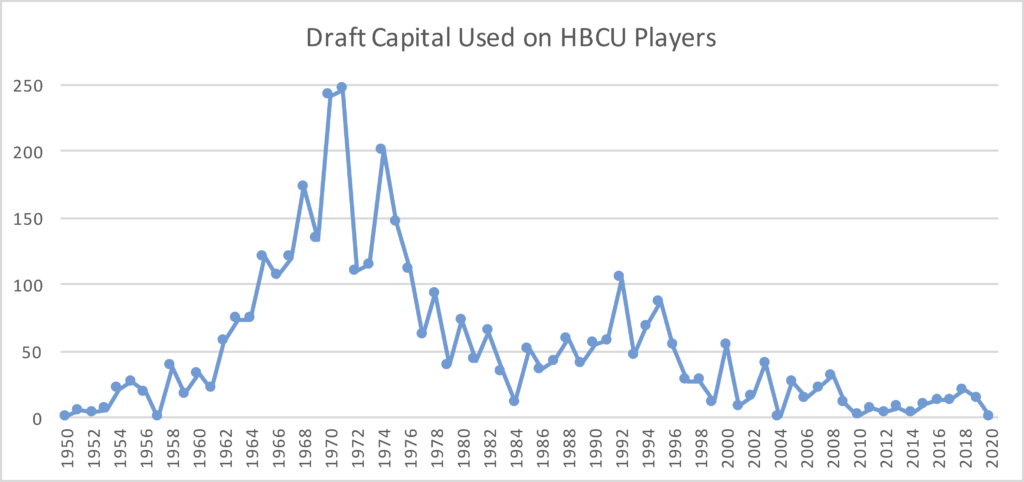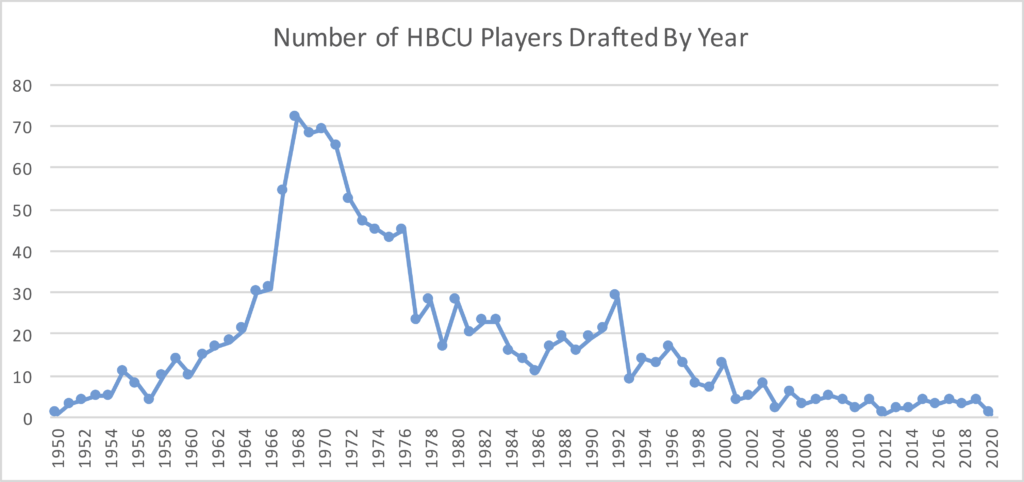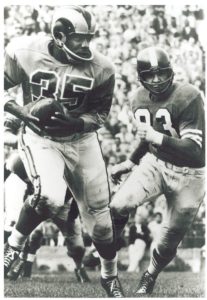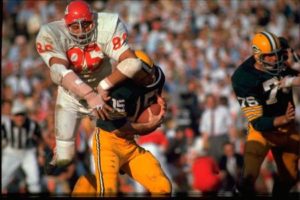The first NFL Draft took place in 1936. But for players attending Historically Black Colleges and Universities (HBCUs), it wasn’t until 1950 that the draft would hold any significance. Later, for a short window in the late ’60s and early ’70s, players from these tiny HBCUs dominated the draft. And finally, with a few notable exceptions, the prominence of HBCU players in the NFL Draft all but disappeared. Today, a look at NFL draft results and how players from HBCUs were valued in each draft. However, to start the story in the 1950s would be woefully inadequate.
In the 1920s, there are a number of black players in the NFL. [1]Fritz Pollard, Duke Slater, Rube Marshall, Inky Williams, Bobby Marshall, Paul Robeson, Joe Lillard, and Ray Kemp, to name a few. But from 1933 to 1945, there was an unofficial ban on black players in the NFL. That ended due to economics, not racial justice. After the 1945 season, Rams owner Dan Reeves decided that Los Angeles would be a better place to house a football team than Cleveland. However, as a condition to playing in the publicly financed Los Angeles Memorial Coliseum, the Rams were required to sign an African American player. That player turned out to be former UCLA star Kenny Washington; a few weeks later, the Rams signed another black player from UCLA, Woody Strode. Together, Washington and Strode re-broke the NFL’s color barrier in 1946 a year before Jackie Robinson did so in major league baseball. [2]Fun fact: Washington, Strode, and Robinson were all teammates in the backfield on the 1939 Bruins team that went undefeated.

Willis (60) and Motley (36) were the first black players to integrate pro football in September 1946.
Meanwhile, in the new All America Football Conference — a rival upstart league to the NFL that launched in 1946 — the Cleveland Browns were integrating pro football. The legendary Paul Brown was in charge of Cleveland, and he signed two black players who would wind up in the Pro Football Hall of Fame. Brown had previously coached both Bill Willis (at Ohio State) and Marion Motley (at Naval Station Great Lakes in Illinois during World War II), so he knew what he was getting when he signed both to become Cleveland Browns in 1946. Meanwhile, Strode was released by the Rams after one season, leaving Washington as the sole black player in the NFL in 1947. In the AAFC, however, things were different: and players from HBCU were coming.
There were 9 black players in the AAFC in 1947, perhaps inspired by the Browns dominating the league in its inaugural season. Those nine included Willis, Motley, and rookie Horace Gillom with the Browns; Gillom had previously played under Paul Brown both in high school and at Ohio State, and became one of the best punters in pro football. A pair of Illinois running backs, Buddy Young (New York Yankees) and Bert Piggott (Los Angeles Dons), also joined the league that year. The Chicago Rockets added Bill Bass, a teammate of Gillom at the University of Nevada, Reno. The other three players were from Historically Black Colleges and Universities: Sugarfoot Anderson (Kentucky State) and John Brown (North Carolina Central College) went to L.A. to play for the Dons, while Elmore Harris (Morgan State) went to the AAFC’s Brooklyn Dodgers.
The AAFC would continue to be ahead on matters of integration, but in 1948, two more NFL teams advanced the ball. Emlen Tunnell, who played at Toledo in ’42, served in the War, and then played at Iowa in ’46 and ’47, joined the New York Giants in 1948; he would eventually become the first African American in the Pro Football Hall of Fame. Meanwhile, Mel Groomes (Indiana) and Bob Mann (Michigan) joined the Lions in 1948. Over in the AAFC, a number of black players entered the league, but none more notable than RB Joe Perry in San Francisco. The future Hall of Fame back led the league in rushing touchdowns his rookie season and helped power arguably the greatest rushing attack in pro football history, averaging over 260 rushing yards per game.
In 1949, two more black players entered the NFL: Wally Triplett (Penn State) joined the Lions, while Tank Younger (Grambling) joined Washington in the backfield with the Rams. In doing so, “Tank” became the first player from an HBCU to play in the NFL. But that was it: as the league exited the 1940s, only the Rams, Giants, and Lions had signed a black player in the decade. [3]Of note, in ’49, the Chicago Bears drafted George Taliaferro (Indiana) in the 13th round, a few rounds before Detroit drafted Tripplett. But Taliferro instead chose to play out west for the … Continue reading
The Rise of HBCUs in The Draft: 1950s
In 1950, the Giants drafted Bob “Stonewall” Jackson out of North Carolina A&M (now North Carolina A&T State University). Another 7 players from HBCUs would be drafted in ’51 and ’52, before New York selected future Hall of Fame left tackle Rosey Brown (Morgan State) in the 27th round of the 1953 Draft. In 1954, fullback Maurice Bassett (Langston) became the highest drafted player from an HBCU when Cleveland and Paul Brown took him in the third round of the ’54 Draft. Two years later, Brown drafted Grambling DE Willie Davis, who would become a Hall of Famer with the Lombardi Packers. And in 1955, the Packers drafted Charlie Brackins out of Prairie View A&M, making him the first quarterback drafted from an HBCU. Another one wouldn’t be drafted for 13 years.
While integration was not easy, it quickly became evident that the league would welcome black players at the running back position. Joe Perry led the league in rushing yards for the 49ers in ’53 and 54; in Los Angeles, Tank Younger led the NFL in yards per carry in ’54 and rushing yards per game in ’55. Not much more needed to be said after Lenny Moore and Jim Brown were drafted in the first rounds of the ’56 and ’57 Drafts: they both became two of the best players in the NFL as soon as they hit the field.
1960s and 1970s: breaking new ground
Chuck Hinton, out of North Carolina College (now North Carolina Central), was a 2nd round pick by Paul Brown’s Browns in 1962. That made the defensive tackle the first player from an HBCU drafted inside the top twenty. [4]The first player chosen that year was one of Brown’s successors at Syracuse, the great Ernie Davis. He would be the first African American drafted by the NFL with the first overall pick. The next year, over in the young American Football League, the Chiefs would change history by using the first overall pick on Grambling’s Buck Buchanan: the defensive tackle would become one of the all-time great defensive players in pro football history. In 1968, the Atlanta Falcons would draft Claude Humphrey with the 3rd overall pick. The 1971 Draft, of course, marked the high-water mark for HBCU players. Three years later, Too Tall Jones out of Tennessee State would go first overall to the Cowboys, another historic mark for HBCUs.
At quarterback, James “Shack” Harris became the first player from an HBCU to have success in the NFL at quarterback. A star at Grambling who fell to the 8th round of the 1969 Draft, Harris spent years as a backup before he led the 1975 Rams to a 12-2 record. Then, in 1978, Grambling’s most notable quarterback, Doug Williams, was drafted in the first round, marking another landmark for players from HBCUs.
And The Fall
The selection of Williams in ’78 was a great moment for HBCU quarterbacks, but the end of an era for the schools as a whole. The 1978 Draft marked the 11th — and final — year in a row that a player from an HBCU was selected in the first round. There were none chosen in 1979, and then in the decade of the 1980s, only three players from HBCUs went in the first round. Two were defensive backs: Roynell Young (Alcorn State) went to the Eagles in 1980 and Rod Hill (Kentucky State) was drafted by the Cowboys in 1982. The third was the greatest player in NFL history, Jerry Rice (Mississippi Valley State), chosen by the 49ers in the 1985 Draft. [5]One future Pro Bowler, Lee Williams (Bethune-Cookman) might have been a first round pick had he not chose to go play in the USFL.
In the 1990s, there were 7 players chosen in the first round from an HBCU: DE Robert Porcher from South Carolina State, G Lester Holmes from Jackson State, DE John Thierry and QB Steve McNair from Alcorn State, DE Hugh Douglas from Central State in Ohio, CB Tyrone Poole from Fort Valley State in Georgia, and OT Jamain Stephens from North Carolina A&T.
In 2000, Jackson State gave the NFL two first round picks: WR Sylvester Morris and CB Rashard Anderson. However, that would be it for eight years: CB Dominique Rodgers-Cromartie (Tennessee State) was the next player from an HBCU to get drafted in the first round, when the Cardinals selected him in 2008. From there, a first round pick wasn’t used on a player from an HBCU until last year, when Houston drafted Alabama State offensive tackle Tytus Howard in the first round. In the 2020 NFL Draft, just one player from an HBCU was selected: the Bears selected G Lachavious Simmons from Tennessee State in the 7th round.
Draft History
Let’s bring a bit of data to the discussion. Using my draft value chart, I calculated how much draft capital was used on players from HBCUs in each draft since Stonewall Jackson was selected in 1950. [6]Note that for the 1961 to 1966 draft seasons, I used the combined AFL/NFL draft values created here. The graph below shows the results: there was a steady rise in league interest in HBCU players in the early ’60s, followed by a a big jump in 1965. That led to about a dozen years of strong showings by players from HBCUs, marked by the big peak in 1971. There was a significant decline in 1978, which reflects the reality that the SEC, ACC, and Texas schools had fully integrated by the mid-1970s.
 Here’s the same information, but using just raw totals on the number of players selected by year. Here the peak comes earlier, as 1967 and 1968 were huge drafts for players from HBCUs. In 1967, there were 38 players from HBCUs drafted after pick 150, with Rayfield Wright (Fort Valley State, Dallas Cowboys) and Ken Houston (Prairie View A&M, Houston Oilers) being the notable late round steals. In 1968, there were 53 draftees after pick 150 from HBCUs, with Harold Jackson (Jackson State, Philadelphia Eagles), and George Atkinson (Raiders) and Tommy Hart (49ers) from Morris Brown being the big steals. [7]These were also huge drafts with well over 400 players taken, which is why I prefer the first chart a bit more. And again, I used the combined AFL/NFL Draft results per this post.
Here’s the same information, but using just raw totals on the number of players selected by year. Here the peak comes earlier, as 1967 and 1968 were huge drafts for players from HBCUs. In 1967, there were 38 players from HBCUs drafted after pick 150, with Rayfield Wright (Fort Valley State, Dallas Cowboys) and Ken Houston (Prairie View A&M, Houston Oilers) being the notable late round steals. In 1968, there were 53 draftees after pick 150 from HBCUs, with Harold Jackson (Jackson State, Philadelphia Eagles), and George Atkinson (Raiders) and Tommy Hart (49ers) from Morris Brown being the big steals. [7]These were also huge drafts with well over 400 players taken, which is why I prefer the first chart a bit more. And again, I used the combined AFL/NFL Draft results per this post.
 Ultimately, the rise and fall of HBCUs is a fascinating but complicated story that can also be summed up succinctly. Due to widespread racist attitudes towards black players, no player from an HBCU entered the NFL until 1950. Due to the segregationist policies at major universities in Texas, the south, and the southest, top black high school athletes in the ’50s, ’60s and early ’70s chose HBCUs. With admission to major college football limited to the west coasts, what is now Big 10 country, or the northeast, southern athletes who wanted (or needed) to stay close to home had no choice but to attend HBCUs. As integration occurred throughout college football in the late ’60s and early ’70s, that resulted in a departure from HBCUs and to the major programs we see today.
Ultimately, the rise and fall of HBCUs is a fascinating but complicated story that can also be summed up succinctly. Due to widespread racist attitudes towards black players, no player from an HBCU entered the NFL until 1950. Due to the segregationist policies at major universities in Texas, the south, and the southest, top black high school athletes in the ’50s, ’60s and early ’70s chose HBCUs. With admission to major college football limited to the west coasts, what is now Big 10 country, or the northeast, southern athletes who wanted (or needed) to stay close to home had no choice but to attend HBCUs. As integration occurred throughout college football in the late ’60s and early ’70s, that resulted in a departure from HBCUs and to the major programs we see today.
References
| ↑1 | Fritz Pollard, Duke Slater, Rube Marshall, Inky Williams, Bobby Marshall, Paul Robeson, Joe Lillard, and Ray Kemp, to name a few. |
|---|---|
| ↑2 | Fun fact: Washington, Strode, and Robinson were all teammates in the backfield on the 1939 Bruins team that went undefeated. |
| ↑3 | Of note, in ’49, the Chicago Bears drafted George Taliaferro (Indiana) in the 13th round, a few rounds before Detroit drafted Tripplett. But Taliferro instead chose to play out west for the AAFC’s Dons, before making three Pro Bowls in the post-merger NFL/AAFC in the 1950s. |
| ↑4 | The first player chosen that year was one of Brown’s successors at Syracuse, the great Ernie Davis. He would be the first African American drafted by the NFL with the first overall pick. |
| ↑5 | One future Pro Bowler, Lee Williams (Bethune-Cookman) might have been a first round pick had he not chose to go play in the USFL. |
| ↑6 | Note that for the 1961 to 1966 draft seasons, I used the combined AFL/NFL draft values created here. |
| ↑7 | These were also huge drafts with well over 400 players taken, which is why I prefer the first chart a bit more. And again, I used the combined AFL/NFL Draft results per this post. |


